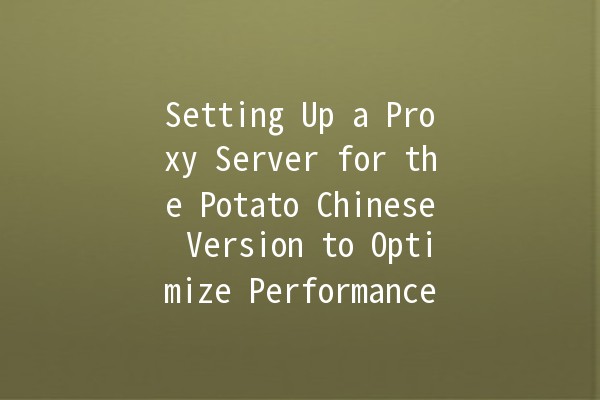In the techsavvy world we live in today, optimizing performance is not just desired but essential for achieving success in various online ventures. One area that has gained significant attention is the configuration of proxy servers. These servers act as intermediaries or gateways between your device and the internet, allowing users to effectively manage data flow, enhance security, and improve overall performance.
When focusing on the Potato Chinese version, the quest to enhance experience translates into achieving fast, uninterrupted access to resources without compromising on security. In this article, we will explore practical strategies to configure a proxy server tailored specifically for the Potato Chinese version and enhance its performance with realworld examples.
Understanding the Need for a Proxy Server 🔍
Proxy servers serve several purposes:

Five Performance Optimization Techniques for Proxy Servers
To effectively optimize your Potato Chinese version's performance through proxy servers, let’s delve into five actionable strategies:
Different types of proxies serve different purposes. When setting up a proxy server for the Potato Chinese version, it’s crucial to determine which type suits your needs best:
HTTP Proxy: Best for web traffic, focusing on HTTP requests and responses.
SOCKS Proxy: More versatile, supporting various types of traffic, including FTP and email.
Transparent Proxy: Doesn’t modify requests but can still cache content, useful for quick retrieval.
Example: If your primary need is to access contentrich websites, an HTTP proxy may offer the best performance. Conversely, if you’re working with a wider variety of data types, a SOCKS proxy could be more appropriate.
The distance between the proxy server and the end user significantly impacts performance. To enhance loading times:
Choose Proxies Near Your Target Audience: Placing your proxy server closer to your users reduces latency.
Utilize Global Proxy Networks: Leverage services that provide proxies in various geographical locations for increased accessibility.
Example: If most of your Potato users are located in China, using a proxy server positioned within the country will lower latency and improve the overall user experience.
Load balancing ensures that no single server gets overwhelmed with traffic, leading to better performance. Here’s how to effectively implement it:
Distribute Traffic Across Multiple Servers: Use tools that automatically reroute requests to the least congested proxy.
Monitor Server Performance: Regularly track performance metrics to adjust load distribution dynamically.
Example: By using advanced load balancing techniques, you could maintain a steady response time even during peak traffic periods for Potato users.
Caching significantly improves load times by storing copies of frequently accessed resources. Here’s how to make the most of it:
Set Up Content Caching: Enable your proxy to cache static resources (images, scripts) to reduce fetch times on repeat requests.
Use CacheControl Headers: Make sure to define how long resources should be cached to optimize freshness.
Example: If your Potato version contains a lot of static assets, caching them via your proxy could result in faster load times, providing a seamless user experience.
Regularly assessing your proxy server’s performance can unveil areas for improvement. Consider the following strategies:
Utilize Performance Monitoring Tools: Tools like New Relic or Datadog can help you monitor the health of your servers effectively.
Analyze Traffic Patterns: Understanding when peak load times occur can inform better resource allocation.
Example: By analyzing traffic when users access the Potato version, you can predict peak times and optimize server resources accordingly.
Common Questions About Proxy Server Configuration 🔧
Proxy servers serve as intermediaries between your device and the internet, enhancing security, speeding up access to data through caching, and allowing you to manage traffic efficiently. For the Potato Chinese version, this translates into improved user experience through low latency and secure content access.
Consider your specific requirements, such as data types accessed, required speed, and geographical considerations. Research various providers that specialize in Chinese internet environments, ensuring they support the Potato version adequately.
Absolutely. Ensure that your proxy server encrypts data and hides IP addresses to protect against cyber threats. Implementing SSL/TLS on proxy servers can significantly boost security measures.
Yes, you can utilize a single proxy server for multiple users, but keep performance monitoring in place. If traffic becomes too heavy, consider upgrading to a dedicated server for critical tasks.
Caching behavior is influenced by several factors, including cachecontrol headers set by the original resource, cache location, and available storage on the proxy server. Optimize these settings based on your content type for best results.
Yes, while proxies can enhance performance and security, some limitations include potential data loss, the risk of misconfigured settings impacting access, and the need for maintenance. Always stay informed and monitor performance to avoid pitfalls.
By employing these strategies to set up your proxy server for the Potato Chinese version, you’ll not only improve performance but also provide a far more secure and engaging experience for your users. Remember that the effectiveness of a proxy server largely depends on thoughtful configuration and continuous monitoring to adapt to evolving needs.